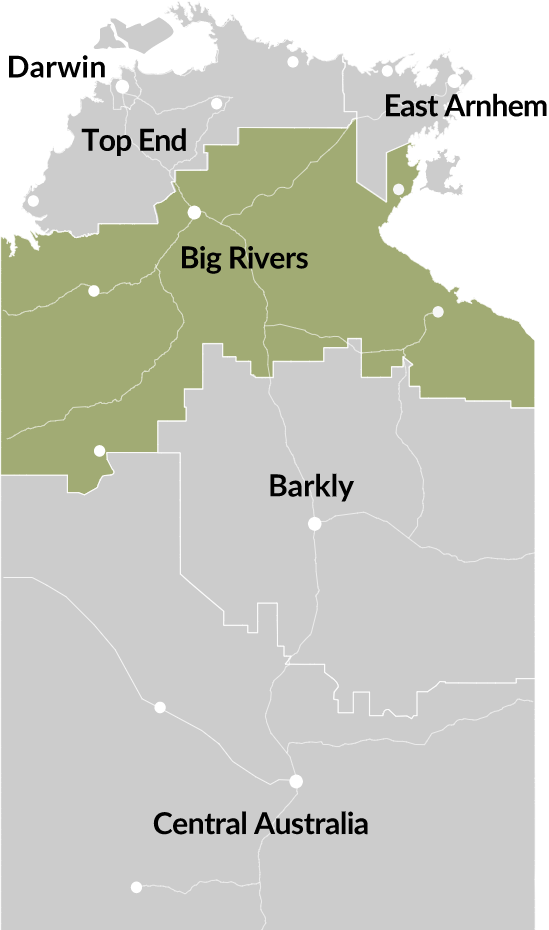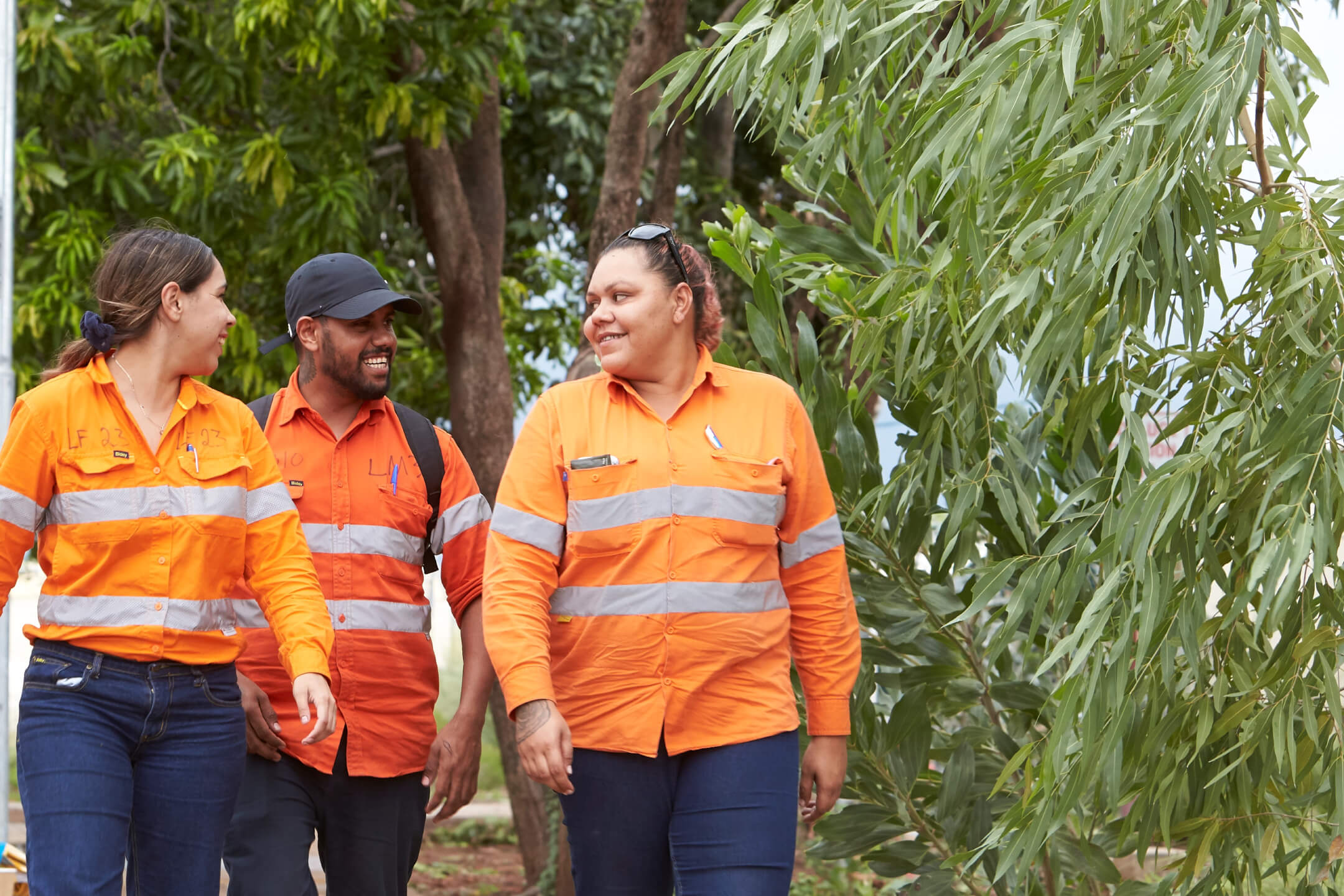Big Rivers
The Big Rivers region is the second largest in the Northern Territory and covers almost 25% of the Territory’s land mass. It stretches from the Western Australia border in the west, along the Gulf of Carpentaria on the Queensland border to the east, and over 500km to the south. The region covers 340,000km² and consists of three Local Government Areas (LGAs): Katherine Town Council, Victoria Daly Regional Council, and Roper Gulf Regional Council.
The Big Rivers region is made up of small communities separated by long distances and is home to about 21,300 people. The town of Katherine is the main centre with a population of about 10,800 people.
Some of the most significant mining and energy activity in Northern Australia is in the Big Rivers region, including one of the largest deposits of zinc-lead in the world at McArthur River.
The region has one of the highest average daily solar exposure rates in Australia.
Additionally, Katherine’s Photovoltaic Park (34 MW) is the largest solar farm in the Northern Territory and a major contributor to the Northern Territory Government’s objective of producing 50% of its energy from renewable sources by 2030.
The Big Rivers region’s gross regional product (GRP) is approximately $1.735 billion, which represents about 7.59% of the Northern Territory’s economy.
It is a critical service hub for the development of the Beetaloo Sub-basin.
The Territory ambition is to achieve a $40 billion economy by 2030. In order to realise this potential, it is projected that 35,000 new jobs will be created over the coming years.
Noting anticipated population growth, a range of affordable housing projects are underway and land releases for residential development are essential to support economic development.
The Northern Territory Government has invested over $40 million in the 2023-24 budget to support expedited residential land releases in the Top End, Katherine in the Big Rivers region and in Tennant Creek in the Barkly region, for residential development.
Recent land releases have been undertaken for the release of the Katherine East Neighbourhood Centre.

Minerals found in the Big Rivers region
Zinc, lead, and silver at McArthur River and ilmenite at SILL80 at Roper River.
Which minerals are found in your home?
View the interactive map to find out
Activity in your region
Company: Glencore
Mine/Project: McArthur River Mine
Mineral/Product: Lead, Zinc, Silver
Overview:
McArthur River, an open-cut mine in the Big Rivers region, produces zinc and lead for use in a wide range of commercial and domestic products. In 2020, McArthur River Mine produced 279,300 tonnes of zinc, 54,900 tonnes of lead and 1.6 million ounces of silver.
Zinc, lead and silver are mined, processed and stored onsite before being transported by truck to a loading facility on the Gulf of Carpentaria, where it is loaded onto ships and shipped to smelters around the world.
McArthur River Mine is located about 970 kilometres southeast of Darwin and has operated since 1995. It is a key contributor to the Northern Territory and national economy, providing significant employment and purchasing of goods and services.
The closest township to the McArthur River Mine is Borroloola. It is located about 60 kilometres southwest of the mine. Borroloola is a small town with a population of about 1,000 people. It is the only town in the area with a school, hospital, and other essential services.
The McArthur River Mine is a remote operation, and most of the workers are fly-in, fly-out (FIFO) employees. However, there is a small number of local workers who are employed at the mine. The mine provides housing support for local workers, such as the provision of home loans and rental assistance.
McArthur River has had a positive impact on the local economy, providing jobs and economic opportunities. It has several programs in place to support the local community, such as the McArthur River Mine Community Benefits Trust (MRM CBT), which commits $1.3 million a year to local projects that support culture and art, enterprise and job creation, social and community development, education, health, and the environment.
MRM community contribution:
- Contributing $477 million to the NT economy.
- Contributes $1.3 million every year to the CBT, which has in turn invested more than $20 million into over 130 programs in areas that include health, education and cultural heritage.
- Supporting over 1,000 suppliers in the region.
- Procuring more than $366 million in goods and services.
- A permanent office in Borroloola for regular engagement with the community.
- Partnering with Borroloola School to provide cash and in-kind support to school activities, including mentoring, coaching, flights, and support for school programs.
- Training and employment programs for local residents.
- A local procurement partnership program with the Northern Territory Industry Capability Network (ICN) and Gulf Region suppliers.
- Working closely with Traditional Owners to respect and preserve the region’s cultural heritage.
- Sponsoring The Li-Anthawirriyarra Sea Ranger Unit, which manages an Indigenous Protected Area of the Gulf of Carpentaria and around the Sir Edward Pellew Islands.
- Sponsoring the Borroloola Sports Association to provide funding for sporting equipment and facilities, the Borroloola Men’s Shed, which provides a space for men to learn new skills, and the Borroloola Women’s Centre, which provides support for women and families.
How many people are employed: 1,060
Mine lifetime: The mine is scheduled to close in 2036.
Rehabilitation plan: The mine has a rehabilitation plan in place that is designed to return the site to a natural state after closure. The rehabilitation plan has been approved by the Northern Territory Government and the Commonwealth Environmental Protection and Biodiversity Conservation Act (EPBC Act). The mine is also required to pay a bond to the Northern Territory Government to ensure that the rehabilitation plan is implemented. The bond is currently set at $200 million.
McArthur River rehabilitation plan includes the following steps:
- The backfilling and regrading of the open pit mine will be done in stages, starting with the shallowest areas first. The waste rock will be backfilled into the pit, and the topsoil will be restored.
- The watercourse will be restored by removing any dams or diversions that have been built for mining purposes. The natural flow of the watercourse will be restored, and any damaged vegetation will be replaced.
- The disturbed areas will be revegetated with native plants that are adapted to the local climate and conditions. The plants will be chosen to help prevent erosion and to provide habitat for wildlife.
- The site will be monitored for at least 10 years after closure to ensure that the rehabilitation plan is working as intended.
- The mine has established an on-site native nursery.
- The mine is located in an area that is home to a number of endangered species. The rehabilitation has been carefully designed to avoid harming these species.
- McArthur River Mine is committed to rehabilitating the site after closure. The mine has a good track record of environmental management, and it is confident that it can successfully implement the rehabilitation plan. Additionally, the Northern Territory Environment Protection Authority (EPA) stated that monitoring has indicated that the McArthur River is in good condition.
Company: Australian Ilmenite Resources (AIR)
Mine/Project: SILL80 Ilmenite Project
Mineral/Product: Ilmenite
Overview:
The SILL80 Ilmenite mine, operated by Australian Ilmenite Resources Pty Ltd (AIR), is a strip mine in the Big Rivers Roper River region that extracts ilmenite, a mineral used in titanium dioxide production. The mine, operational since 2013, has an estimated 4.5 million tonnes of ilmenite and a predicted lifespan of at least 20 years.
Employing around 100 people, of which 20% are from the Mataranka town, the mine has generated income for the Northern Territory government by paying $1.2 million in royalties in 2022. It has also created economic opportunities and sponsored events while supporting health care and housing for local workers. The mine has a processing plant that can process up to 100,000 tonnes of ilmenite per year and a rehabilitation plan to restore the land to its initial state after mining operations conclude.
The SILL80 mine has implemented programs to support the local Aboriginal community, including a cultural heritage program, an employment program for Aboriginal participation in the workforce, and a community development program that funds projects for the local community. Additionally, the mine has a target of increasing Indigenous employee representation to 30% by 2025.
The SILL80 Ilmenite mine is a vital economic asset for the Northern Territory, providing employment, revenue, and opportunities for the local community. Its programs for supporting the Mataranka community, Aboriginal people, and the environment, demonstrate its commitment to social responsibility.
Community benefits:
- Contributing $1.2 million to the NT economy in 2022.
- Jobs and economic opportunities for the local community.
- Programs to support the local Aboriginal people including:
- A cultural heritage program that works to protect and preserve the cultural heritage of the local Aboriginal people.
- An employment program that aims to increase the participation of Aboriginal people in the workforce at the mine.
- A community development program that provides funding for projects that benefit the local community.
Specific benefits the town of Mataranka and funded by the SILL 80 mine include:
- A new health clinic — 2018.
- A new sports complex — 2019.
- A new swimming pool — 2020.
- A new road to the mine — 2021.
- A new school — 2022.
- Contributed to the construction of a new library and a new community centre.
- Funded other projects, such as a tree planting program and a youth development program.
How many people are employed: 100.
Mine lifetime: The mine is scheduled to close in 2033.
Rehabilitation plan: The SILL80 mine has a rehabilitation plan that will restore the land to its original condition after mining is complete. The rehabilitation plan has been approved by the Northern Territory Environmental Protection Authority (EPA). The EPA will monitor the implementation of the plan to ensure that it is being carried out effectively.
As an important part of the SILL80 mine project, the plan ensures the land will be restored to its original condition after mining is complete and that the environment will be protected.
The plan includes the following steps:
- Progressive rehabilitation over the life of mining means some areas will be rehabilitated as soon as they are mined, while other areas will be rehabilitated later.
- The land will be rehabilitated to a healthy perennial grass rangeland with a diverse mix of plants, both native and introduced (i.e. non-declared species).
- Processed soil will be returned to mined pits, which will then be broadcast with perennial grass seeds and covered with weed-free pasture hay.
- Cattle will be introduced to the area for a short and controlled period to initiate sowing of seeds and stimulate ground preparation.
- As a perennial grass rangeland develops, the area will be grazed systematically, for a period of up to 20 years.
